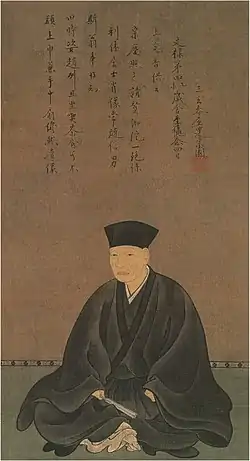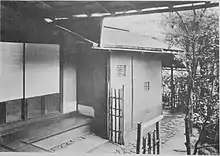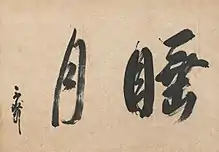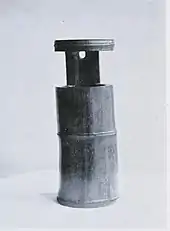Sen no Rikyū
Sen no Rikyū (千利休, 1522 – April 21, 1591), also known simply as Rikyū, is considered the historical figure with the most profound influence on chanoyu, the Japanese "Way of Tea", particularly the tradition of wabi-cha. He was also the first to emphasize several key aspects of the ceremony, including rustic simplicity, directness of approach and honesty of self. Originating from the Sengoku period and the Azuchi–Momoyama period, these aspects of the tea ceremony persist.[1] Rikyū is known by many names; for consistency, he will be referred to as Rikyū in this article.

There are three iemoto (sōke), or "head houses" of the Japanese Way of Tea, that are directly descended from Rikyū: the Omotesenke, Urasenke, and Mushakōjisenke, all three of which are dedicated to passing forward the teachings of their mutual family founder, Rikyū.
Early life
Rikyū was born in Sakai in present-day Osaka Prefecture. His father was a warehouse owner named Tanaka Yohei (田中与兵衛), who later in life also used the family name Sen, and his mother was Gesshin Myōchin (月岑妙珎).[2] His childhood name was Yoshiro.[3]
As a young man, Rikyū studied tea under the townsman of Sakai named Kitamuki Dōchin (1504–62),[4] and at nineteen, through Dōchin's introduction, he began to study tea under Takeno Jōō, who is also associated with the development of the wabi aesthetic in tea ceremony. He is believed to have received the Buddhist name Sōeki (宗易) from the Rinzai Zen priest Dairin Sōtō (1480–1568) of Nanshūji temple in Sakai.[5] He married a woman known as Hōshin Myōju (d. 1577) around when he was twenty-one.[6] Rikyū also underwent Zen training at Daitoku-ji temple in Kyoto. Not much is known about his middle years.
Later years
In 1579, at the age of 58, Rikyū became a tea master for Oda Nobunaga[7] and, following Nobunaga's death in 1582, he was a tea master for Toyotomi Hideyoshi.[8] His relationship with Hideyoshi quickly deepened, and he entered Hideyoshi's circle of confidants, effectively becoming the most influential figure in the world of chanoyu.[9] In 1585, because he needed extra credentials in order to enter the Imperial Palace so that he could help at a tea gathering that would be given by Hideyoshi for Emperor Ōgimachi and held at the Imperial Palace, the emperor bestowed upon him the Buddhist lay name and title "Rikyū Koji" (利休居士).[10] Another major chanoyu event of Hideyoshi's that Rikyū played a central role in was the Grand Kitano Tea Ceremony, held by Hideyoshi at the Kitano Tenman-gū in 1587.



It was during his later years that Rikyū began to use very tiny, rustic tea rooms referred as sō-an ("grass hermitage"), such as the two-tatami mat tea room named Tai-an, which can be seen today at Myōki-an temple in Yamazaki, a suburb of Kyoto, and which is credited to his design. This tea room has been designated as a National Treasure. He also developed many implements for tea ceremony, including flower containers, teascoops, and lid rests made of bamboo, and also used everyday objects for tea ceremony, often in novel ways.
Raku teabowls were originated through his collaboration with a tile-maker named Raku Chōjirō. Rikyū had a preference for simple, rustic items made in Japan, rather than the expensive Chinese-made items that were fashionable at the time. Though not the inventor of the philosophy of wabi-sabi, which finds beauty in the very simple, Rikyū is among those most responsible for popularizing it, developing it, and incorporating it into tea ceremony. He created a new form of tea ceremony using very simple instruments and surroundings. This and his other beliefs and teachings came to be known as sōan-cha (the grass-thatched hermitage style of chanoyu), or more generally, wabi-cha. This line of chanoyu that his descendants and followers carried on was recognized as the Senke-ryū (千家流, "school of the house of Sen").
A writer and poet, the tea master referred to the ware and its relationship with the tea ceremony, saying, "Though you wipe your hands and brush off the dust and dirt from the vessels, what is the use of all this fuss if the heart is still impure?"[11]
Two of his primary disciples were Nanbō Sōkei (南坊宗啓; dates unknown), a somewhat legendary Zen priest; and Yamanoue Sōji (1544–90), a townsman of Sakai. Another was Furuta Oribe (1544-1615), who became a celebrated tea master after Rikyū's death. Nanbō is credited as the original author of the Nanpō roku, a record of Rikyū's teachings. There is, however, some debate as to whether Nanbō even existed, and some scholars theorize that his writings were actually by samurai litterateur Tachibana Jitsuzan (1655-1708), who claimed to have found and transcribed these texts.[12] Yamanoue's chronicle, the Yamanoue Sōji ki (山上宗二記), gives commentary about Rikyū's teachings and the state of chanoyu at the time of its writing.[13]
Rikyū had a number of children, including a son known in history as Sen Dōan, and daughter known as Okame. This daughter became the bride of Rikyū's second wife's son by a previous marriage, known in history as Sen Shōan. Due to many complex circumstances, Sen Shōan, rather than Rikyū's legitimate heir, Dōan, became the person counted as the 2nd generation in the Sen-family's tradition of chanoyu (see "san-Senke" at schools of Japanese tea ceremony).
Rikyū also wrote poetry, and practiced ikebana.
One of his favourite gardens was said to be at Chishaku-in in Kyoto.[14]
Death
Although Rikyū had been one of Hideyoshi's closest confidants, because of crucial differences of opinion and because he was too independent, Hideyoshi ordered him to commit ritual suicide.[15] One year earlier after the Siege of Odawara (1590), his famous disciple Yamanoue Sōji was tortured and decapitated on Hideyoshi's orders. While Hideyoshi's reason may never be known for certain, it is known that Rikyū committed seppuku at his residence within Hideyoshi's Jurakudai villa in Kyoto in 1591 on the 28th day of the 2nd month (of the traditional Japanese lunar calendar; or April 21 when calculated according to the modern Gregorian calendar), at the age of seventy.[3][16]
According to Okakura Kakuzō in The Book of Tea, Rikyū's last act was to hold an exquisite tea ceremony. After serving all his guests, he presented each piece of the tea-equipage for their inspection, along with an exquisite kakemono, which Okakura described as "a wonderful writing by an ancient monk dealing with the evanescence of all things". Rikyū presented each of his guests with a piece of the equipment as a souvenir, with the exception of the bowl, which he shattered, as he uttered the words: "Never again shall this cup, polluted by the lips of misfortune, be used by man." As the guests departed, one remained to serve as witness to Rikyū's death. Rikyū's last words, which he wrote down as a death poem, were in verse, addressed to the dagger with which he took his own life:
Welcome to thee,
O sword of eternity!
Through Buddha
And through Daruma alike
Thou hast cleft thy way.[17]
When Hideyoshi was building his lavish residence at Fushimi the following year, he remarked that he wished its construction and decoration to be pleasing to Rikyū. Hideyoshi was known for his temper, and is said to have expressed regret at his treatment of Rikyū.[18]
Rikyū's grave is located at Jukōin temple in the Daitoku-ji compound in Kyoto; his posthumous Buddhist name is Fushin'an Rikyū Sōeki Koji.
Memorials for Rikyū are observed annually by many schools of Japanese tea ceremony. The Omotesenke school's annual memorial takes place at the family's headquarters each year on March 27, and the Urasenke school's takes place at its own family's headquarters each year on March 28. The three Sen families (Omotesenke, Urasenke, Mushakōjisenke) take turns holding a memorial service on the 28th of every month, at their mutual family temple, the subsidiary temple Jukōin at Daitoku-ji temple.
In popular culture
Rikyu (利休 Rikyū, 1989) is Hiroshi Teshigahara's film about the master. The film focuses on the late stages of life of Rikyū, during the highly turbulent Sengoku period of feudal Japan. The film won a number of awards.
Death of a Tea Master (千利休 本覺坊遺文, Sen no Rikyu: Honkakubô ibun also known as Sen no Rikyū: Honkakubo's Student Writings) is a 1989 biographical drama film directed by Kei Kumai with Toshiro Mifune as the lead character. It is based on the events surrounding his ritual suicide. It was entered into the main competition at the 43rd Venice International Film Festival, in which it won the Silver Lion.
Hyouge Mono (へうげもの Hyōge Mono, "Jocular Fellow") is a manga written and illustrated by Yoshihiro Yamada. Hyōge Mono is a fictional retelling of the era in which Sen no Rikyū lived, and how close tea culture was to the world of politics. It won several comic awards and was adapted into an anime series in 2011.
Ask This of Rikyu (利休にたずねよ, Rikyū ni tazuneyo) was made in 2013 by Mitsutoshi Tanaka, starring kabuki actor Ichikawa Ebizō XI, Rei Dan, Akira Emoto, and Seiji Fukushi. It is based on a novel by Kenichi Yamamoto.[19]
Sen no Rikyū is one of the main characters in Flower and Sword (花戦さ Hana Ikusa), a 2017 tragicomical movie by Tetsuo Shinohara. The role of Rikyū is performed by Kōichi Satō.
Notes
- Birmingham Museum of Art (2010). Birmingham Museum of Art : guide to the collection. [Birmingham, Ala]: Birmingham Museum of Art. p. 48. ISBN 978-1-904832-77-5.
- Rikyū Daijiten (Rikyū Encyclopedia). Tankosha, 1989. ISBN 4-473-01110-0.
- "The Urasenke Legacy: Family Lineage", in Urasenke website. Accessed May 16, 2006.
- Anderson, Jennifer L. (1991). An introduction to the Japanese tea ritual. Albany, New York: State University of New York. p. 35. ISBN 0-7914-0749-7.
- Nishibe Bunjo, "Zen priests and Their Concepts of Tea," p. 13, in Chanoyu Quarterly no. 13 (1976).
- Rikyū Daijiten, entry for Hōshin Myōju
- Anderson, p. 36.
- Anderson, p. 37
- Rikyū Daijiten entries for 当世の風体 (the trend of the age) and 豊臣秀吉の側近 (Toyotomi Hideyoshi's confidant).
- "The Urasenke Legacy: Family Lineage", in Urasenke website. Accessed May 16, 2006.
- Sadler, A. L. Cha-no-yu: The Japanese Tea Ceremony. Rutland, VT and Tokyo: Tuttle, 1962.
- Rath, Eric C. "Reevaluating Rikyû: Kaiseki and the Origins of Japanese Cuisine" in The Journal of Japanese Studies, vol. 39, no. 1, winter 2013, pp. 67-96
- Rikyū Daijiten
- http://www.japantimes.co.jp/life/2014/03/29/lifestyle/chishaku-in-a-kyoto-garden-of-deep-repose/
- Ohki, Sadako; Yale University. Art Gallery (2009). Tea Culture of Japan. Yale University Art Gallery. ISBN 978-0-300-14692-9.CS1 maint: ref=harv (link)
- Okakura Kakuzo, The Illustrated Book of Tea (Okakura's classic with 17th-19th century ukiyo-e woodblock prints and a chapter on Sen no Rikyu). Chiang Mai: Cognoscenti Books. 2012. ASIN: B009033C6M
- Okakura, Kakuzo, The Book of Tea pp 64-65. Toronto: Dover Publications. 1964.
- Sansom, George (1961). "A History of Japan: 1334-1615." Stanford, California: Stanford University Press. pp364,370.
- IMDB
References
- Bodart-Bailey, Beatrice. (1977). Tea and counsel, the political rele of Sen Rikyū. OCLC 469293854
- Sansom, George Bailey. (1961). A History of Japan: 1334-1615. London: Cresset Press. OCLC 216583509
Further reading
External links
| Wikimedia Commons has media related to Sen no Rikyū. |
- Sen no Rikyū at Find a Grave
- Momoyama, Japanese Art in the Age of Grandeur, an exhibition catalog from The Metropolitan Museum of Art (fully available online as PDF), which contains material on Sen no Rikyū
- Turning point : Oribe and the arts of sixteenth-century Japan, an exhibition catalog from The Metropolitan Museum of Art (fully available online as PDF), which contains material on Sen no Rikyū
